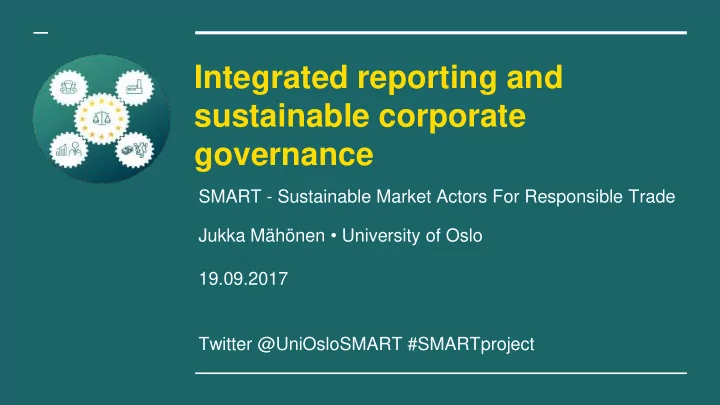

Integrated reporting and sustainable corporate governance SMART - Sustainable Market Actors For Responsible Trade Jukka Mähönen • University of Oslo 19.09.2017 Twitter @UniOsloSMART #SMARTproject
SMART analyses the regulatory complexity within which European market actors operate. With a focus especially on international supply chains of products sold in Europe, the aim is to find out what prevents and what promotes a shift towards sustainable development. SMART is funded by the European Union
Introduction Corporate governance A ‘system by which companies are directed and controlled’ (Cadbury Report, 1992) System = ‘financial aspects of corporate governance’ = shareholder value Board’s & management’s accountability to providers of financial capital Question: Is there room and possibilities of more ‘integrated’ thinking? Corporate governance codes: South Africa, Malaysia, Philippines eg . The South African ‘King tradition’
Introduction Integrated thinking integrated reporting Integrated thinking connect the use of integrated reporting to report on an organisation’s corporate governance practices and economic -social- environmental triple-bottom-line performance. On focus here: Where integrated reporting leads us? especially the International Integrated Reporting Council’s International <IR> Framework?
The <IR> Framework based on an idea of ‘shared value creation’ by providers of the ‘six capitals’ financial, manufactured, intellectual, human, societal and environmental capitals Represents in the text a stakeholder management model (p. 2) stakeholder management integrated - at least on the text level - in many corporate governance codes
Integrated thinking Enlarging in the text level the concept of capital providers from shareholders only to other internal stakeholders Goal of capital efficiency and profit maximisation from financial capital only to other five forms of internal capital provisions?
’Business model ’ Crucial for <IR> represents the way how an organisation creates value comprising all its activities, its relationships with stakeholders and its tangible and intangible assets and liabilities board responsibilities: ‘corporate governance’ = sustaining and developing the company’s business model Question: what kind of ‘business model’ integrated reporting based corporate governance really reflects, and how it possible varies from shareholder-centred business model?
Paper 1. What kind of stakeholder model, if any, integrated reporting and especially International <IR> Framework represents 2. What is the impact, if any, of integrated reporting to material corporate governance in the codes it is included in
Paper 3. Does an integrated view represent a genuine ‘corporate sustainability’ business model based on policy coherence for a life-cycle based sustainable circular economy to operationalise the planetary boundaries and to integrate the UN Sustainability Development Goals as entity based sustainable value creation, or is it only a view to encourage organisations to take care of the profits of capital providers
The <IR> model Integrated thinking in <IR> active consideration by an organization of the relationships between its various operating and functional units and the capitals that the organization uses or affects (p 2) Business model in <IR> draws on various capitals as inputs and, through its business activities, converts them to outputs (para. 2.23)
Why integrated thinking fails? <IR> integrated thinking requires a business to reconsider the short, medium and long term sustainability of the entity It would require that the firm should report on all the capitals that are affected by its activities Problem: <IR> does not follow integrated thinking in the end does however vice versa as capitals are reported only if they provide value to the firm If the firm causes externalities, decreasing the value of the capitals outside the organisation, they are not reported
Why integrated thinking fails? Main reason: the ‘primary purpose of an integrated report is to explain to providers of financial capital how an organization creates value over time. It therefore contains relevant information, both financial and other’ ( para 1.7, emphasis added) Business case = shareholder primacy: the ‘primary purpose of an integrated report to explain to providers of financial capital how an organization creates value over time’ Ignoring sustainability, stakeholder thinking, future generations (Flower 2015)
Business case The primary purpose of <IR> to explain the firm’s value creation to financial investors and hence ‘value’ has to be interpreted according to their interests ‘interested in the value an organization creates for itself. They are also interested in the value an organization creates for others when it affects the ability of the organization to create value for itself’ ( para 2.5, emphasis added) ‘financial returns to the providers of financial capital’ ( para 2.4)
Conclusion Clear resemblance between the <IR> Framework and section 172 of the UK Companies Act 2006 Both <IR> and s 172 CA adopt the same approach: the firm should maximize long-term value for shareholders, and, to achieve this, it should have proper regard for the interest of others As s 172 CA, <IR> as a safeguard of environmental and social interests illusory (cf Tsagas 2017) Both prioritise financial investors’ interests over stakeholders’ interests
Conclusion Additionally, the mode of regulation in either of the framework do not provide substantive content to integrated thinking with the visibility that is necessary for it to be functionally a viable way of stakeholders’ featuring in corporate decision-making as a matter of best practice (cf. Tsagas 2017) As section 172 CA, also <IR> gives the illusion that something is being done to acknowledge stakeholders’ interests in corporate decision -making Way forward? Appointment of Richard Howitt to CEO of the IIRC Integration to human rights due diligence and sustainability? (cf. Monciardini et al 2017)
Click to add text
Thank you! jukka.mahonen@jus.uio.no Twitter jukkamahonen #PublicMarketActors #SustainablePublicActors #SUPA SMART is funded by the European Union under the Horizon 2020 programme, grant agreement 693642. The contents of this presentation are the sole responsibility of the SMART project and do not necessarily reflect the views of the European Union.
Recommend
More recommend